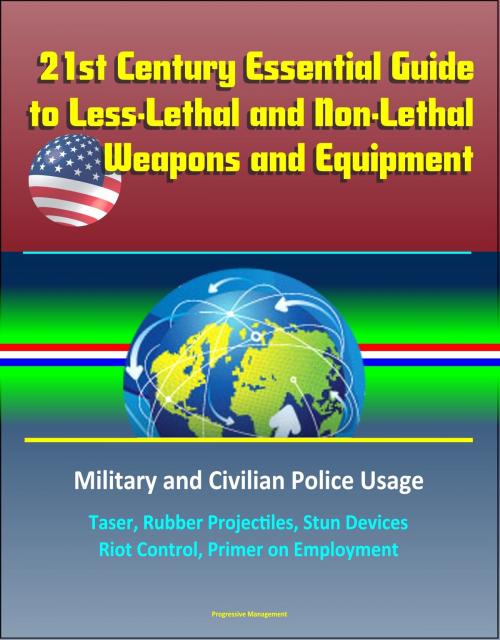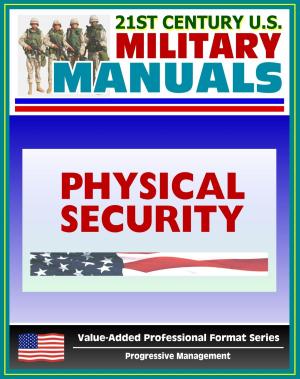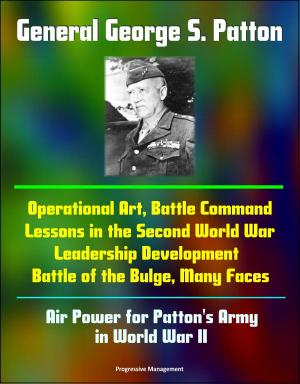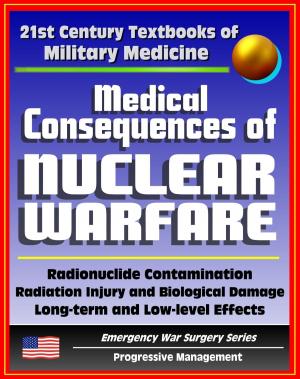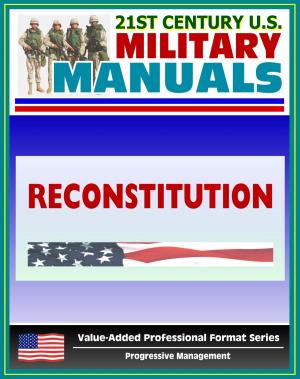21st Century Essential Guide to Less-Lethal and Non-Lethal Weapons and Equipment: Military and Civilian Police Usage - Taser, Rubber Projectiles, Stun Devices, Riot Control, Primer on Employment
Nonfiction, Social & Cultural Studies, Political Science, Politics, Law Enforcement, History, Military, Weapons| Author: | Progressive Management | ISBN: | 9781370197170 |
| Publisher: | Progressive Management | Publication: | March 8, 2017 |
| Imprint: | Smashwords Edition | Language: | English |
| Author: | Progressive Management |
| ISBN: | 9781370197170 |
| Publisher: | Progressive Management |
| Publication: | March 8, 2017 |
| Imprint: | Smashwords Edition |
| Language: | English |
This excellent compilation of reports has been professionally converted for accurate flowing-text e-book format reproduction. It includes a reproduction of important documents from the Department of Justice and U.S. Military about less-lethal and non-lethal weapons and equipment for military and civilian usage, including a DOD Review of Nonlethal Weapons, A Research Guide for Civil Law Enforcement and Corrections, A Primer on the Employment of Non-Lethal Weapons from the Navy, and an Air Force paper on the Potential Strategic Blessing and Curses of Non-Lethal Weapons on the Battlefield.
Under its Less-Lethal Technologies Program, established in 1986, the National Institute of Justice (NIJ) the research, development, and evaluation arm of the U.S. Department of Justice provides funds to identify, develop, and evaluate new or improved devices and other technology that will minimize the risk of death and injury to law enforcement officers, suspects, prisoners, and the general public. Many Federal, State, and local civil law enforcement and corrections agencies use less-lethal weapons and equipment to help minimize the loss of life and property. These devices are used to quell prison riots, suppress mobs, and subdue hostile individuals. NIJ has prepared this equipment review to inform Federal, State, and local agencies about the Department of Defense (DoD) Joint Nonlethal Weapons Program and the less-lethal weapons and equipment used by civil law enforcement agencies. This review does not address issues surrounding DoD s Joint Nonlethal Weapons Program or issues related to nonlethal weapons research and development programs.
DoD has deployed less-lethal technology under its Joint Nonlethal Weapons Program since 1995, when civil agencies provided less-lethal weapons and equipment, technical assistance, and training to support the U.S. military s redeployment to Somalia. The technology enables U.S. forces to reduce unintended casualties and infrastructure damage during complex missions; discourage, delay, or prevent hostile action; limit escalation where lethal force is not the preferred option; protect U.S. forces; and temporarily disable equipment and facilities. Currently used DoD and U.S. Coast Guard nonlethal weapons and equipment are described in sections II and III. Section IV includes representative descriptions of less-lethal devices used by the Chicago Police Department, Los Angeles County Sheriff s Department, Metropolitan Police Department of Washington, D.C., Philadelphia Special Weapons and Tactics (SWAT) team, Seattle SWAT team, and U.S. Marshals Service.
The product descriptions include photographs and information about manufacturers, costs, the services or law enforcement agencies that use each product, and each item s operational capability or use. Agencies that lack adequate research and development funding for less-lethal weapons and equipment often rely on private manufacturers to meet this need. A review of this equipment is provided for the Army, Marine Corps, Navy, USAF, Special Operations Command, and Coast Guard. Some of the weapons covered include: Nonballistic Face Shield; Body Shield; Riot Shinguards; Ballistic Face Shield; Ballistic Body Shield With Light Kit; Riot Shinguards.; Expandable Baton; Wooden Baton; Portable Bullhorn; Ground-Mounted Bullhorn; Individual Voice Amplification System (M7); High-Intensity Light; Disposable Restraint System; Individual Riot Control Agent Dispenser/Carry Pouch; Inert Individual Riot Control Agent Dispenser; High-Capacity Oleoresin Capsicum (OC) Dispenser; Squad Riot Control Agent Dispenser; Refill Unit Riot Control Agent; 12-Gauge Shotgun With High-Intensity Light Kit; Gauge Gunstock Carrier (6 Round); 12-Gauge Launching Cup; 12-Gauge Utility Pouch (25 Round); 40 mm Carry Pouch; Diversionary/Rubber Ball Grenade Pouch; Caltrops; Roadside Spike Strip; Riot Training Suit With Accessories; Riot Training Bag.
This excellent compilation of reports has been professionally converted for accurate flowing-text e-book format reproduction. It includes a reproduction of important documents from the Department of Justice and U.S. Military about less-lethal and non-lethal weapons and equipment for military and civilian usage, including a DOD Review of Nonlethal Weapons, A Research Guide for Civil Law Enforcement and Corrections, A Primer on the Employment of Non-Lethal Weapons from the Navy, and an Air Force paper on the Potential Strategic Blessing and Curses of Non-Lethal Weapons on the Battlefield.
Under its Less-Lethal Technologies Program, established in 1986, the National Institute of Justice (NIJ) the research, development, and evaluation arm of the U.S. Department of Justice provides funds to identify, develop, and evaluate new or improved devices and other technology that will minimize the risk of death and injury to law enforcement officers, suspects, prisoners, and the general public. Many Federal, State, and local civil law enforcement and corrections agencies use less-lethal weapons and equipment to help minimize the loss of life and property. These devices are used to quell prison riots, suppress mobs, and subdue hostile individuals. NIJ has prepared this equipment review to inform Federal, State, and local agencies about the Department of Defense (DoD) Joint Nonlethal Weapons Program and the less-lethal weapons and equipment used by civil law enforcement agencies. This review does not address issues surrounding DoD s Joint Nonlethal Weapons Program or issues related to nonlethal weapons research and development programs.
DoD has deployed less-lethal technology under its Joint Nonlethal Weapons Program since 1995, when civil agencies provided less-lethal weapons and equipment, technical assistance, and training to support the U.S. military s redeployment to Somalia. The technology enables U.S. forces to reduce unintended casualties and infrastructure damage during complex missions; discourage, delay, or prevent hostile action; limit escalation where lethal force is not the preferred option; protect U.S. forces; and temporarily disable equipment and facilities. Currently used DoD and U.S. Coast Guard nonlethal weapons and equipment are described in sections II and III. Section IV includes representative descriptions of less-lethal devices used by the Chicago Police Department, Los Angeles County Sheriff s Department, Metropolitan Police Department of Washington, D.C., Philadelphia Special Weapons and Tactics (SWAT) team, Seattle SWAT team, and U.S. Marshals Service.
The product descriptions include photographs and information about manufacturers, costs, the services or law enforcement agencies that use each product, and each item s operational capability or use. Agencies that lack adequate research and development funding for less-lethal weapons and equipment often rely on private manufacturers to meet this need. A review of this equipment is provided for the Army, Marine Corps, Navy, USAF, Special Operations Command, and Coast Guard. Some of the weapons covered include: Nonballistic Face Shield; Body Shield; Riot Shinguards; Ballistic Face Shield; Ballistic Body Shield With Light Kit; Riot Shinguards.; Expandable Baton; Wooden Baton; Portable Bullhorn; Ground-Mounted Bullhorn; Individual Voice Amplification System (M7); High-Intensity Light; Disposable Restraint System; Individual Riot Control Agent Dispenser/Carry Pouch; Inert Individual Riot Control Agent Dispenser; High-Capacity Oleoresin Capsicum (OC) Dispenser; Squad Riot Control Agent Dispenser; Refill Unit Riot Control Agent; 12-Gauge Shotgun With High-Intensity Light Kit; Gauge Gunstock Carrier (6 Round); 12-Gauge Launching Cup; 12-Gauge Utility Pouch (25 Round); 40 mm Carry Pouch; Diversionary/Rubber Ball Grenade Pouch; Caltrops; Roadside Spike Strip; Riot Training Suit With Accessories; Riot Training Bag.
